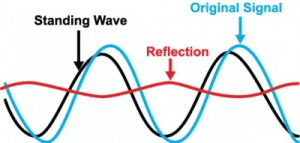Noise Figure (NF) describes the amount of noise a component, amplifier, or an entire radio receive chain contributes to the RF signal being received. Electrical noise is combined with the RF signal as it is generated by the RF transmitter and propagated through space. This signal is then captured by the receiving antenna and guided to the receiver input via a transmission line. In an ideal receiver, each amplifier stage would increase the desired signal and the surrounding noise floor by the same amount, or in other words, the amplifiers would not add any additional noise to the signal. This would mean that the signal to noise ratio (SNR) would remain constant throughout the stages of the receive circuit.
In reality, amplifier stages add additional noise to the signals passing through them. In the worst-case scenario, this means that through several gain stages the noise floor rises at a greater rate than the desired signal level, which and can eventually envelop the desired signal and prevent reception of the signal altogether. With an effort to reduce cost, the radio designer may select inexpensive transistors or amplifier ICs for the receiver gain stages. Unfortunately, these devices may not be designed for low noise applications and will have poor NF performance.
For a high-performance receiver, all gain stages should have the lowest possible NF values. However, because this may be cost prohibitive, significant improvement in system NF is achieved by simply insuring that the first gain stage is a quality LNA device. There are two options for implementation of the LNA in existing equipment: (1) the first gain stage in the receiver is replaced with a low NF device by the original equipment manufacturer (OEM), or (2) an external LNA is placed between the antenna and the receiver. In many instances, adding an external LNA presents the most cost-effective option when compared with the costs of a modification to an existing receiver.
Receiver Noise Figure Calculation
Data sheets for amplifier devices typically provide NF characteristics for one or more frequency bands and different operating conditions. Although NF ratings cannot be simply summed or multiplied, the individual NF values can be used to estimate the NF of the entire cascaded amplifier section. The NF numbers must first be converted to Noise Factor (F) values. Noise Factor is the ratio of the input signal to noise ratio (ratio of signal level versus channel noise level, or signal to noise ratio (SNR) versus the output SNR of the component or circuit. Noise Factor is found using the following equation:
NF = 10 * LOG10 (F), or F = 10(NF/10)
To demonstrate this let’s compare two receive chains, one without an LNA (Figure 1) and one with an LNA included (Figure 2):

Figure 1.
NFcircuit = 10 * LOG10 (2.061) = 3.14 dB

Figure 2.
NF circuit + LNA = 10 * LOG10 (1.312) = 1.18 dB
Improvement due to the µHILNATM = NF circuit – NF circuit + LNA = 3.14 – 1.18 = 1.96 dB
The addition of the NuWaves µHILNATM (Figure 3) to the front end of a receiver with a high NF has improved the receiver noise figure by approximately 2 dB.
 Figure 3. NuWaves’ µHILNATM Low Noise Amplifier (LNA) operates from 50 to 1500 MHz, delivers 20 dB of gain, with less than 1 dB of Noise Figure (NF) and a Third-Order Intermodulation Product (IP3) of +31 dBm.
Figure 3. NuWaves’ µHILNATM Low Noise Amplifier (LNA) operates from 50 to 1500 MHz, delivers 20 dB of gain, with less than 1 dB of Noise Figure (NF) and a Third-Order Intermodulation Product (IP3) of +31 dBm.
Noise figure is a key measurement of the performance of an RF receiver. While the peak performance is gained by selecting LNA devices with the lowest possible noise figures, good performance is achieved by using a high quality, low noise figure device as the first gain stage in the receiver. Further, the noise figure of a receiver can be improved through the addition of an external LNA placed between the receive antenna and the receiver. NuWaves offers several LNA modules in the NuWaves product line, including the µHILNATM, providing low noise gain solutions from 2 MHz to 10 GHz.
NuWaves RF Solutions has developed a wide variety of off-the-shelf RF amplifiers with rich features to support mission-critical CONOPS in telemetry, ISR, and tactical communication systems applications. Frequency ranges are available from UHF through C-band with output power levels ranging from 5 to 100 Watts NuPowerTM PAs and NuPower XtenderTM BDAs are designed, built and tested in-house under NuWaves’ Quality Management System (QMS) certified to AS9100:2009 and ISO 9001-2008 standards, which ensures that each product arrives on-time and defect-free. Most models are in-stock and are available for same-day shipment on orders placed before 2pm.
NuWaves also boasts a full suite of state-of-the-art design and simulation tools, test and measurement equipment, prototyping equipment and a full-scale production facility to provide custom solutions to your specifications. Contact NuWaves today to extend the range of your communications systems and don’t forget to check out our RF Amplifiers and Frequency Converters.


